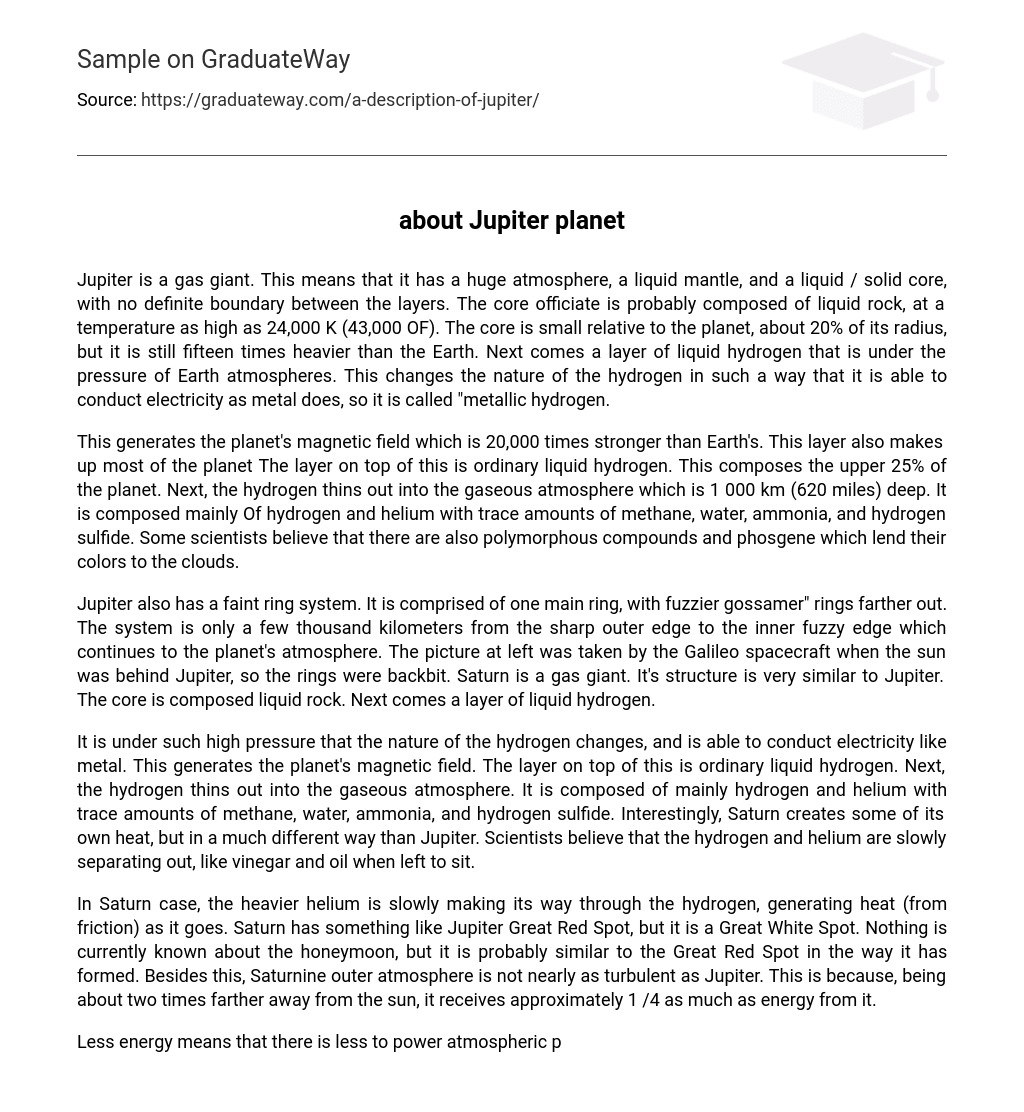Jupiter is a gas giant. This means that it has a huge atmosphere, a liquid mantle, and a liquid / solid core, with no definite boundary between the layers. The core officiate is probably composed of liquid rock, at a temperature as high as 24,000 K (43,000 OF). The core is small relative to the planet, about 20% of its radius, but it is still fifteen times heavier than the Earth. Next comes a layer of liquid hydrogen that is under the pressure of Earth atmospheres. This changes the nature of the hydrogen in such a way that it is able to conduct electricity as metal does, so it is called “metallic hydrogen.
This generates the planet’s magnetic field which is 20,000 times stronger than Earth’s. This layer also makes up most of the planet The layer on top of this is ordinary liquid hydrogen. This composes the upper 25% of the planet. Next, the hydrogen thins out into the gaseous atmosphere which is 1 000 km (620 miles) deep. It is composed mainly Of hydrogen and helium with trace amounts of methane, water, ammonia, and hydrogen sulfide. Some scientists believe that there are also polymorphous compounds and phosgene which lend their colors to the clouds.
Jupiter also has a faint ring system. It is comprised of one main ring, with fuzzier gossamer” rings farther out. The system is only a few thousand kilometers from the sharp outer edge to the inner fuzzy edge which continues to the planet’s atmosphere. The picture at left was taken by the Galileo spacecraft when the sun was behind Jupiter, so the rings were backbit. Saturn is a gas giant. It’s structure is very similar to Jupiter. The core is composed liquid rock. Next comes a layer of liquid hydrogen.
It is under such high pressure that the nature of the hydrogen changes, and is able to conduct electricity like metal. This generates the planet’s magnetic field. The layer on top of this is ordinary liquid hydrogen. Next, the hydrogen thins out into the gaseous atmosphere. It is composed of mainly hydrogen and helium with trace amounts of methane, water, ammonia, and hydrogen sulfide. Interestingly, Saturn creates some of its own heat, but in a much different way than Jupiter. Scientists believe that the hydrogen and helium are slowly separating out, like vinegar and oil when left to sit.
In Saturn case, the heavier helium is slowly making its way through the hydrogen, generating heat (from friction) as it goes. Saturn has something like Jupiter Great Red Spot, but it is a Great White Spot. Nothing is currently known about the honeymoon, but it is probably similar to the Great Red Spot in the way it has formed. Besides this, Saturnine outer atmosphere is not nearly as turbulent as Jupiter. This is because, being about two times farther away from the sun, it receives approximately 1 /4 as much as energy from it.
Less energy means that there is less to power atmospheric phenomenon. Uranus was the first planet to be discovered in modern history. It was actually discovered by accident in 1 781 by William Herschel. Like the other gas giants, Uranus has a very thick cloud cover and an atmosphere made up mostly of hydrogen, Ilium, methane, and ammonia. The trace amount of methane is what gives Uranus and its twin, Neptune, their blue color. Unlike Saturn and Jupiter, Uranus has a different internal structure. The core of Uranus is probably composed of liquid rock.
Then, farther up, the liquid rock slowly gives way to an ocean made mostly of hydrogen, helium, and water, with small amounts of ammonia and methane. This “ocean” accounts for most of Uranus bulk. Then, the water slowly thins out into the bland, almost featureless atmosphere. Uranus also has a system of about 1 1 rings – not nearly as large as Saturn. Nine were found when Uranus passed in front of a bright star in 1977, for the rings causing the star to temporarily disappear when they passed in front of it.
This was the first time astronomers had detected rings around any planet other than Saturn. It was the first time, also, that astronomers had detected thin rings around any planet. The other two rings were found when Voyager 2 passed by. Uranus also has 27 known moons, most of which little is known about. Neptune, like its twin, Uranus, has an atmosphere composed of hydrogen, helium, methane, and ammonia. The methane creates the blue color. Neptune internal structure is also the same as that of Uranus. The core of Neptune is probably composed of liquid rock.
Then, farther up, the liquid rock slowly gives way to an ocean, primarily containing hydrogen, helium, and water, but also ammonia and methane. This “ocean” accounts for most of Neptune bulk. The ocean slowly thins out into the atmosphere. This atmosphere contains much more detail than Uranus’. It has swirls of clouds and high-altitude cirrus clouds, as well as gigantic storms. Neptune also has a faint system of rings. The rings are made of pieces of material the size of a car or truck. There is about one thousandth of the matter in Neptune rings as in Uranus’.





